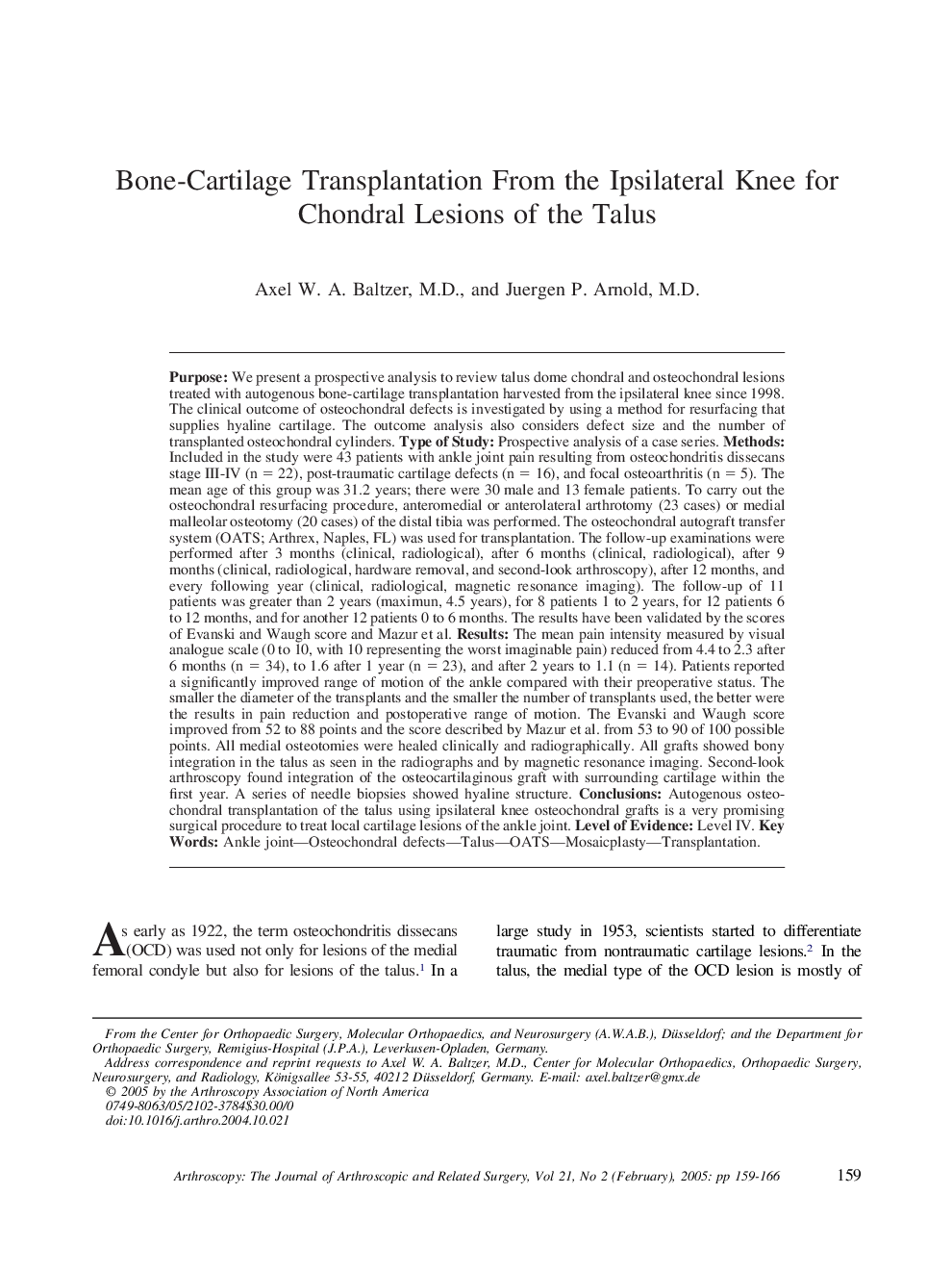| کد مقاله | کد نشریه | سال انتشار | مقاله انگلیسی | نسخه تمام متن |
|---|---|---|---|---|
| 10079236 | 1603627 | 2005 | 8 صفحه PDF | دانلود رایگان |
عنوان انگلیسی مقاله ISI
Bone-cartilage transplantation from the ipsilateral knee for chondral lesions of the talus
دانلود مقاله + سفارش ترجمه
دانلود مقاله ISI انگلیسی
رایگان برای ایرانیان
کلمات کلیدی
موضوعات مرتبط
علوم پزشکی و سلامت
پزشکی و دندانپزشکی
ارتوپدی، پزشکی ورزشی و توانبخشی
پیش نمایش صفحه اول مقاله

چکیده انگلیسی
Purpose: We present a prospective analysis to review talus dome chondral and osteochondral lesions treated with autogenous bone-cartilage transplantation harvested from the ipsilateral knee since 1998. The clinical outcome of osteochondral defects is investigated by using a method for resurfacing that supplies hyaline cartilage. The outcome analysis also considers defect size and the number of transplanted osteochondral cylinders. Type of study: Prospective analysis of a case series. Methods: Included in the study were 43 patients with ankle joint pain resulting from osteochondritis dissecans stage III-IV (n = 22), post-traumatic cartilage defects (n = 16), and focal osteoarthritis (n = 5). The mean age of this group was 31.2 years; there were 30 male and 13 female patients. To carry out the osteochondral resurfacing procedure, anteromedial or anterolateral arthrotomy (23 cases) or medial malleolar osteotomy (20 cases) of the distal tibia was performed. The osteochondral autograft transfer system (OATS; Arthrex, Naples, FL) was used for transplantation. The follow-up examinations were performed after 3 months (clinical, radiological), after 6 months (clinical, radiological), after 9 months (clinical, radiological, hardware removal, and second-look arthroscopy), after 12 months, and every following year (clinical, radiological, magnetic resonance imaging). The follow-up of 11 patients was greater than 2 years (maximun, 4.5 years), for 8 patients 1 to 2 years, for 12 patients 6 to 12 months, and for another 12 patients 0 to 6 months. The results have been validated by the scores of Evanski and Waugh score and Mazur et al. Results: The mean pain intensity measured by visual analogue scale (0 to 10, with 10 representing the worst imaginable pain) reduced from 4.4 to 2.3 after 6 months (n = 34), to 1.6 after 1 year (n = 23), and after 2 years to 1.1 (n = 14). Patients reported a significantly improved range of motion of the ankle compared with their preoperative status. The smaller the diameter of the transplants and the smaller the number of transplants used, the better were the results in pain reduction and postoperative range of motion. The Evanski and Waugh score improved from 52 to 88 points and the score described by Mazur et al. from 53 to 90 of 100 possible points. All medial osteotomies were healed clinically and radiographically. All grafts showed bony integration in the talus as seen in the radiographs and by magnetic resonance imaging. Second-look arthroscopy found integration of the osteocartilaginous graft with surrounding cartilage within the first year. A series of needle biopsies showed hyaline structure. Conclusions: Autogenous osteochondral transplantation of the talus using ipsilateral knee osteochondral grafts is a very promising surgical procedure to treat local cartilage lesions of the ankle joint. Level of evidence: Level IV.
ناشر
Database: Elsevier - ScienceDirect (ساینس دایرکت)
Journal: Arthroscopy: The Journal of Arthroscopic & Related Surgery - Volume 21, Issue 2, February 2005, Pages 159-166
Journal: Arthroscopy: The Journal of Arthroscopic & Related Surgery - Volume 21, Issue 2, February 2005, Pages 159-166
نویسندگان
Axel W.A. M.D., Juergen P. M.D.,